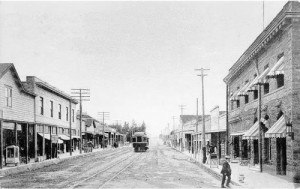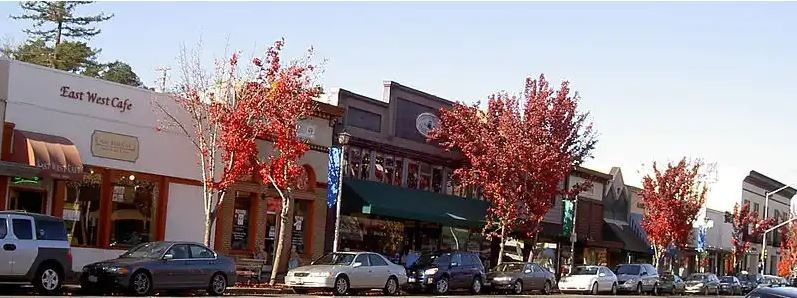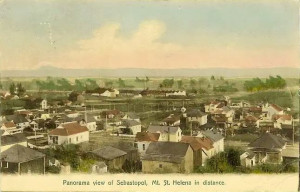The Town of
Sebastopol
- Genealogy
- History of Sebastopol
- The Town Today
- Places of Interest
- People of Interest
Table of Contents
Sebastopol is a city in Sonoma County, in California with a recorded population of 7,379, per the 2010 U.S. Census. Sebastopol was once primarily a plum and apple-growing region. Today, wine grapes are the predominant agriculture crop, and nearly all lands once used for orchards are now vineyards. The creation of The Barlow, a $23.5 million strip mall on a floodplain at the edge of town, converting old agriculture warehouses into a trendy marketplace for fine dining, tasting rooms, and art, has made Sebastopol a popular Wine Country destination. Famous horticulturist Luther Burbank had gardens in this region. The city hosts an annual Apple Blossom Festival in April and is home to the Sebastopol Documentary Film Festival. [1]
Sebastopol is situated on the edge of the Laguna de Santa Rosa, which is fed by Santa Rosa Creek and other tributaries, including three minor tributaries within the city limits – Zimpher Creek, Calder Creek and Witter Creek. The Laguna is a wetland area that is home to many species of wildlife and vegetation and divides the town from neighboring Santa Rosa. Nearly every winter the Laguna floods, cutting off State Route 12, and often flooding the low-lying businesses and homes on the eastern side of Sebastopol. The Pitkin Marsh lily and White sedge are two rare species of plants that are found in the vicinity of Sebastopol. The city has a total area of 1.9 sq mi (4.9 km2), all land. [1]
Genealogy
Gedcom Index for Sebastopol, CA. . . . Link . . Link
Surnames: Armstrong, Brians, Bruce, Dei, Finley, Gager, Garloff, Head, Jones, Kaseman, Linebaugh, Lowrey, McKune, Mecham, Middleton, Mills, Nickle, Oehlman, Pack, Piazza, Pitkin, Starkey, Stemple, Stine, Tuck, Valentine
LDS genealogy.com: Sebastopol . . . Link
Roadside Thoughts: Sebastopol California . . . Link
Sonoma
County Genealogical Society . . . Link
The web site "The Cockrill Family of Sonoma County" [Link] has a wonderful collection of local genealogy including the following with ties to this town: Annie. E. McReynolds, George William McReynolds, Henry Andrew Hardin, Jacob McReynolds Jr., James Allen Hardin, James Madison McReynolds, John Smith Hagans, Larkin Cockrill, Mary Hagans, Mary Jane Hardin, Matilda Fuller, Obadiah Haight Hoag, Robert Hardin, Sara Ellen McReynolds, Stephen McReynolds, Talitha Cooper, Victoria Showalter, William A. Hagans, Willkiam Jefferson Hardin
History of Sebastopol
The area's first known inhabitants were the native Coast Miwok and Pomo peoples. The town currently sits atop multiple village sites. The town of Sebastopol formed in the 1850s with a U.S. Post Office and as a small trade center for the farmers of the surrounding agricultural region. As California's population swelled after the westward migration and the California Gold Rush of 1848–1855, more and more settlers drifted into the fertile California valleys north of San Francisco to try their hand at farming. [1]
There is some debate as to how the name "Sebastopol" came into use in Sonoma County. At one time, four other California towns were also named Sebastopol: one in Napa County, renamed Yountville; one in Tulare County; one in Sacramento County; one in Nevada County. The town in Sonoma County originally had the name Pinegrove; the name change (according to rumor) had something to do with a bar fight in the late 1850s, which was compared by a bystander to the long British siege of the seaport of Sevastopol (1854–1855) during the Crimean War of 1853–1856. The original name survives in the name of the Pine Grove General Store downtown. [1]
Sebastopol became known as the "Gravenstein Apple Capital of the World". The apple industry brought a steady rural prosperity to the town. In 1890 the San Francisco and North Pacific Railroad connected Sebastopol to the national rail network. The town was incorporated in 1902, with schools, churches, hotels, canneries, mills, wineries, and an opera house to its credit. The 1906 earthquake reduced most of these early buildings to rubble (Sebastopol is only seven miles from the city of Santa Rosa, the worst-hit town in the 1906 earthquake), but as elsewhere in the county, the town was rebuilt. In the second half of the 20th century, the apple industry struggled to compete with other apple-producing regions and gradually declined in economic significance. With greater personal mobility and the rise of larger shopping centers in other Sonoma County communities, many residents now often commute to work and shop in the neighboring towns of Rohnert Park or Santa Rosa, while Sebastopol maintains its small-town charm. [1]
It is often incorrectly claimed that Sebastopol was the last town in Northern California to have working railroad trains on Main Street. The tracks were removed in the late 1980s. Passenger service had ceased in the 1930s, and regular freight service ended in the late 1970s. This was documented by Analy High School students in a 1979 video Our Train Down Main: a History of the Petaluma and Santa Rosa Railroad. The canneries and apple-processing plant are gone from downtown, and vineyards and housing developments have replaced many apple orchards, reducing the demand for freight service. It is often also incorrectly stated that the tracks were removed in the 1990s when the downtown area was redesigned with two one-way streets to enhance traffic along Gravenstein Highway (Route 116). Main Street and Petaluma Avenue were actually designated one-way streets in 1985 in an attempt to deal with the town's perennial traffic problem. As of 2016 the old train station houses the Western County Museum. [1]
Sebastopol
One
of the first settlers in the Sebastopol area was Jasper
O'Farrell, who bought the Rancho Estero Americano in 1843.
Joaquin Carrillo was the first Sebastopol resident,
building his adobe house on his Llano de Santa Rosa
Rancho, in 1846. In 1850, John Walker and Joseph Miller
located near Carrillo's adobe and Walker opened a trading
post. The town of Sebastopol was founded by J. H. P.
Morris, in 1855, when he took up a claim of 120 acres, on
the site of a Pomo Village. The same year, Morris opened a
saloon, John Dougherty opened a general merchandise store
nearby, in a grove of pine that gave the town it's first
name of Pine Grove. The Analy Post Office was moved from
Analy to Sebastopol in 1867. Captain Auser started the
first hotel in town. John Bowman bought out Auser, and
Henry Wilson succeeded him in 1859. . . .
[Archived Website. Link]
Barlow History . . . Link
History of Sebastopol [City Page] . . . Link
Historical Society . . . Link
Link to the Past [YouTube video] . . . Link
Check Sonoma Historian [SCHS] for articles about the towns. . . . Link
The
Town Today
American Towns . . . Link
Experience Sebastopol . . . Link
LocalWiki: Sebastopol . . . Link
Sebastopol Homepage . . . Link
Sebastopol Today [Niche] (has a map of location) . . . Link
Sonoma County Life Opens Up: Sebastopol . . . Link
Visit California: Sebastopol . . . Link
Wikipedia Page . . . Link
WikiVoyage: Sebastopol . . . Link
Places of Interest
Barlow, an outdoor mall east of town, built on the floodplain of the Laguna de Santa Rosa . . . Link
George A. Strout House . . . Wikepedia . . . Image . . . Wikiwand . . .
Guayaki Sustainable Rainforest Products world headquarters . . . Wikepedia
Hallberg Butterfly Gardens . . . Wikepedia . . . Main Site . . . History . . . Pac. Horticulture
Hessel Grange . . . Link
Hogan Building. . . Wikipedia . . . Image . . . Historical Marker
This was the Power House for the Petaluma and Santa Rosa Railroad, an electric railway. The first cars were run on the line in 1904, and the later named Hogan Building, built of stone from a local quarry, is one of the few in the area that made it through the 1906 earthquake
Ives Park, summer home of the Sonoma County Repertory Theater . . . Link
Joe Rodota Trail . . . Wikepedia
The trail was built on the former roadbed of the Petaluma and Santa Rosa Railroad built in 1904 to provide interurban service from a ferry connection in Petaluma through Sebastopol to Santa Rosa. The line was purchased by the Northwestern Pacific Railroad in 1932. The right-of-way was converted to a walking and bicycle path by the Sonoma County Regional Parks Department after declining freight traffic caused abandonment of rail service over the route in the 1980s. The trail is named after Joseph “Joe” Rodota, Sr, father of writer and political consultant Joseph Rodota, Jr.; Rodota, Sr. was the county's district's first director.
Laguna de Santa Rosa . . . Wikepedia
Luther Burbank's Gold Ridge Experiment Farm . . . Wikepedia
Ragle Ranch Regional Park . . . Wikepedia
Sebastopol Center for the Arts . . . Link
Sebastopol Community Cultural Center . . . Link
Sturgeon Mills . . . Wikepedia
Sturgeon’s Mill is a Working Museum. It began its life in 1913 when Wade Sturgeon set up the sawmill in Coleman Valley several miles inland from the Pacific Ocean. The mill operated there till 1923 when it was dismantled, loaded on wagons and pulled by horses seven miles further inland and reassembled at its present location on Green Hill road Sebastopol CA. In 1943 the mill was sold to partners Ralph Sturgeon and James E. Henningsen. They ran the mill until it was closed in 1964. This shuttered mill then slumbered for 30 years.
West County Museum . . . Link
Operated by the Western Sonoma County Historical Society in the former Petaluma and Santa Rosa Railroad passenger depot.
West County Trail . . . Link
People of Interest
Alfred Hallberg . . . Link
In 1911, Alfred Hallberg, their oldest son, married Della Wirts and eventually assumed responsibility for running the ranch. He too was a trustee at Oak Grove School, where his two daughters, Louise and Esther [Hallberg], were students through the eighth grade.
Captain Auser [First Hotel
Owner] . . . Link . . Captain Auser started
the first hotel in town.
Elizabeth Waters Burbank (1888-1977) . . . Link
George A. Strout [See George A. Strout House above] . . . Link
George Strout, one of Sebastopol's early mayors, bought a lot at 253 Florence Avenue from Gertrude Huntley in 1901 and built a Queen Anne Victorian for his family in 1903.
Gertrude Huntley . . . Link . . . Sold her lot at 253 Florence Avenue to George A Strout.
Henry Wilson [First Hotel 3rd Owner] . . . Link . . John bought out Auser [First Hotel], and Henry Wilson succeeded him in 1859.
James E. Henningsen . . Link
In 1943 the [Sturgeons] mill was sold to partners Ralph Sturgeon and James E. Henningsen. They ran the mill until it was closed in 1964.
Jasper O'Farrell . . .Link . . Wikipedia . .
One of the first settlers in the Sebastopol area was Jasper O'Farrell, who bought the Rancho Estero Americano in 1843.
Joseph H. P. Morris . . . Link . . . Bio on p.353-355 [Internet Archive]
The town of Sebastopol was founded by J. H. P. Morris, in 1855, when he took up a claim of 120 acres, on the site of a Pomo Village. The same year, Morris opened a saloon
Joaquin Carrillo . . . Link . . was the first Sebastopol resident, building his adobe house on his Llano de Santa Rosa Rancho, in 1846.
John Bowman [First Hotel 2nd Owner] . . . Link . . John bought out Auser [First Hotel], and Henry Wilson succeeded him in 1859.
John Dougherty . . . Link . . opened
a general merchandise store nearby, in a grove of pine
that gave the town it's first name of Pine Grove.
John F. Hallberg . . . Link . . . Bio [GenWeb Archive]
In 1883, John F. Hallberg bought 40 acres of scrub timber and brush on Sebastopol's outskirts, initiating the roots of the Hallberg Butterfly Gardens. He and his wife, Louisa Neta Pearson, prospered on their ranch, which eventually spread to 130 acres. They raised hops, berries, cherries, prunes, pears, apples, and three children. John was a trustee of the nearby Oak Grove school.
John Walker . . . Link . . . Bio [GenWeb Archive] . .
. . . until 1850, when he came to Sonoma county, settling in Santa Rosa valley. That same year he built the first redwood house in the valley, near where Sebastopol is now located. In 1851, in partnership with Joseph Morgan Miller, he established the first merchandise store in the county outside the town of Sonoma, and the first postoffice of the country roundabout was kept in the old house now standing at the rear of the old Walker homestead in Analy township.
Joseph “Joe” Rodota, Sr. . . . Wikipedia
The [“Joe” Rodota] trail is named after Joseph “Joe” Rodota, Sr., father of writer and political consultant Joseph Rodota, Jr.; Rodota, Sr. was the county's district's first director.
Joseph Morgan Miller . . . Link . . In 1850, John Walker and Joseph Miller located near Carrillo's adobe and Walker opened a trading post.
Louise Hallberg (1917-2017) The butterfly lady! . . . Link
Luther Burbank (1849-1926) . . . Link
Ralph Sturgeon . . Link
In 1943 the [Sturgeons] mill was sold to partners Ralph Sturgeon and James E. Henningsen. They ran the mill until it was closed in 1964.
Thomas Edgar Barlow . . . Link . . . Bio [GenWeb Archive]
Thomas Barlow and his family established themselves as important apple and berry farmers in these early years. In 1939 two of Thomas Barlow’s sons constructed an applesauce canning facility to process apples from the more than 11,000 acres of orchards nearby.
Wade Sturgeon . . . Link
Sturgeon’s Mill is a Working Museum.
It began its life in 1913 when Wade
Sturgeon set up the sawmill in Coleman Valley
several miles inland from the Pacific Ocean.
Maps
Experience Sebastopol . . . Link
Map of Sebastopol, with boundaries
[BingMaps] . . . Link
Map of Sebastopol [MapQuest] . . .
Link
Sebastopol Chamber of Commerce Map . . . Link
Photos
Town, 1955 . . . Link
Citations
[1] Wikipedia contributors. "Sebastopol, California." Wikipedia, The Free Encyclopedia. Wikipedia, The Free Encyclopedia, 2 Sep. 2022. Web. 11 Sep. 2022 . . . . Link
[2] "Historical and Descriptive Sketch Book of Napa, Sonoma, Lake, and Mendocino: Comprising Sketches of Their Topography, Productions, History, Scenery, and Peculiar Attractions", C.A. Menefee, 1873 . . . Link
[3] "Historical and Descriptive Sketch of Sonoma County, California", Robert Allan Thompson. L.H. Everts, 1877 - Sonoma County (Calif.) - 104 pages. [ ??? pp 100-101] . . . Link
[4] "History of Sonoma County: Including Its Geology, Topography, Mountains, Valleys and Streams ...."' United States, Higginson Book Company, 1880. (page ???.) . . . Link . . . Text at CAGenWeb
[5] "An Illustrated History of Sonoma County, California: Containing a History of the County of Sonoma from the Earliest Period of Its Occupancy to the Present Time", Lewis Publishing, 1889 . . . Link


